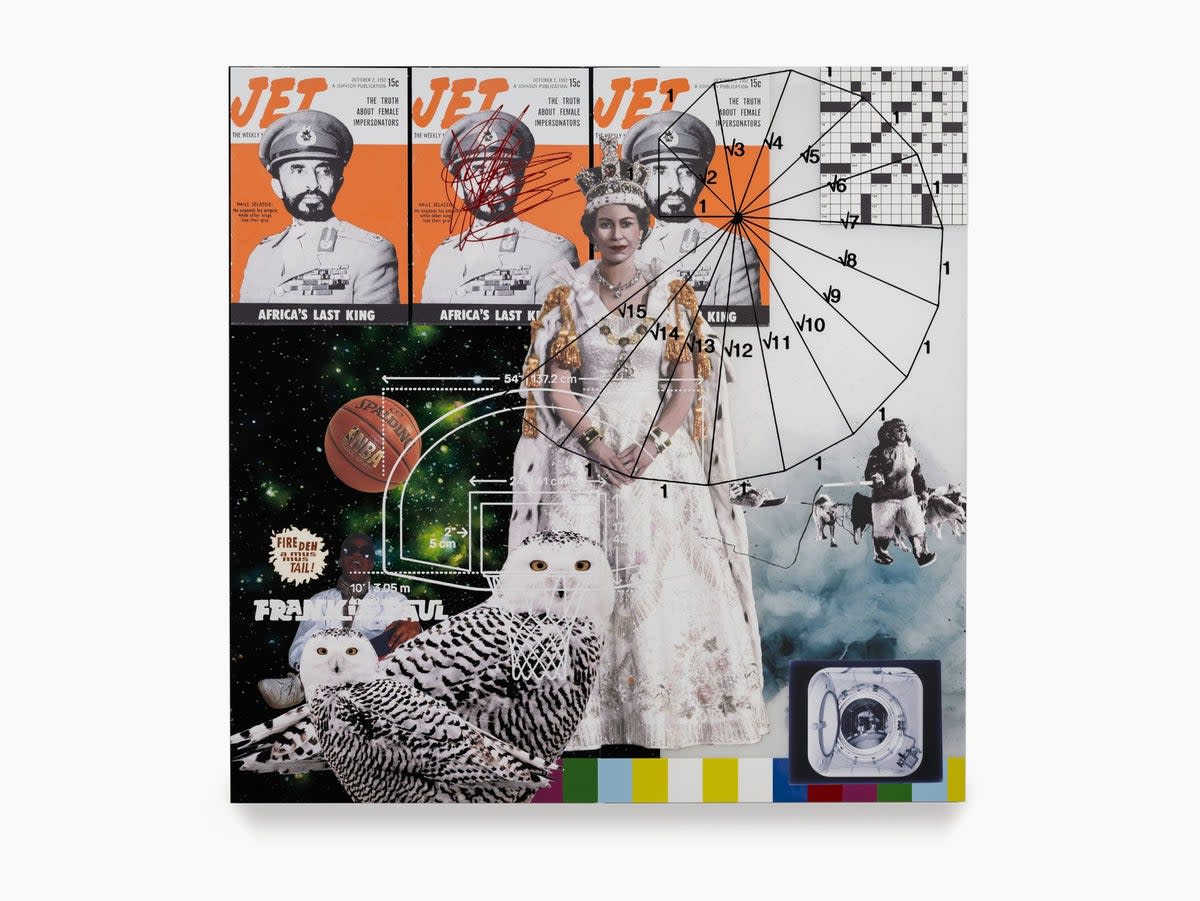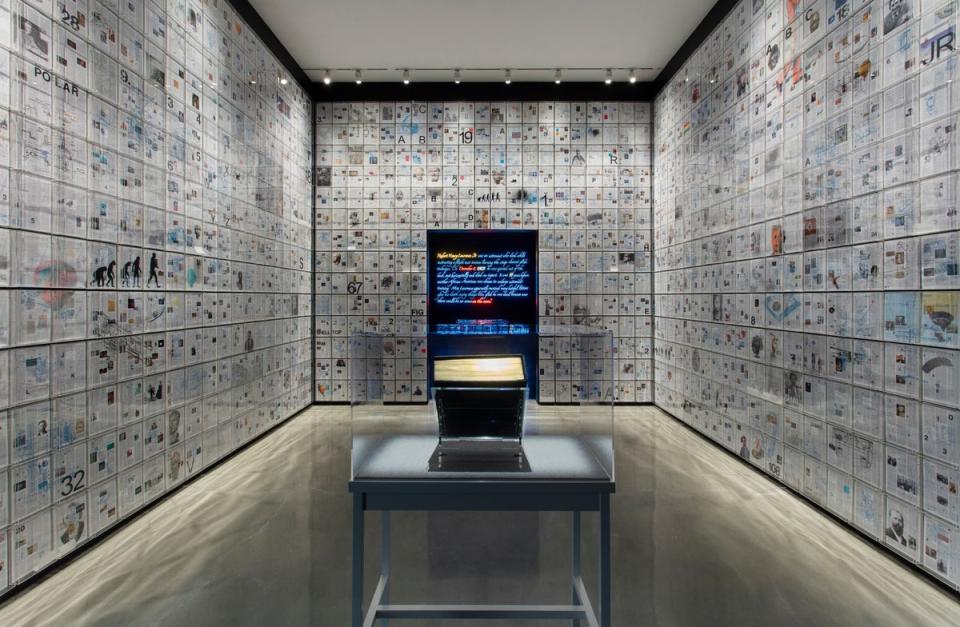Tavares Strachan at the Hayward Gallery review – imaginative show delights, informs and calls us to action

Wherever you are on the ground floor of the Hayward Gallery, you hear voices speaking the words of James Baldwin. The quote they narrate provides the title of Tavares Strachan’s show, and it also appears as a neon text in a darkened room.
Strachan’s excerpt of the text begins, “One discovers the light…”, and ends, “It is necessary, while in darkness, to know that there is a light somewhere, to know that in oneself, waiting to be found, there is a light.”
Messages lurk within the wider text. The first and last words, “one” and “light”, are in yellow; the rest in white. Occasionally, most of the neon flashes off, leaving the simple phrase, “One discovers… there is a light.” And while the voices begin in unison, they soon then fragment and overlap.
Baldwin’s quote can be interpreted broadly, of course. But here, in the first major museum survey anywhere of the Bahamian-born artist’s work, it’s difficult to avoid the sense of a journey in search of knowledge – partly a personal one for Strachan, but also a universal one, on which he brings us.
Across the Hayward’s two floors, his art compels us to respond to stories of individuals and diverse, African diasporic cultures and how they intertwine.
He seeks to unearth “hidden histories and to tell lost stories”, he says. Some of the heroes whose stories Strachan tells are unknown to most of us, like the first African American astronaut, Robert Henry Lawrence, and Matthew Henson, the African American explorer who was the first man to reach the North Pole – before Robert Peary, who Henson accompanied on the expedition, yet took sole credit.
It’s a reflection of the rich through-lines in this show that Henson appears in multiple works, rendered in sculpture and various pieces in two-dimensions, and paid homage to in Strachan’s own journey to the Pole, captured in a lightbox photograph, among other things.

Henson’s photographic image appears in Four Hundred Meter Dash (2018), an example of what Strachan calls Invisibility Paintings – dynamic collisions of imagery. They include, here, diagrams of a running track and volleyball tactics, a doubled image of Queen Elizabeth II, and the dancehall legend Yellowman.
The images oscillate and overlap, challenging us to connect them: the Queen as a symbol of empire, the head of state of the Bahamas in which Strachan grew up, Henson as an emblem both of conquest and those left behind and dominated by it, Yellowman as the kind of musical figure from whom Strachan learnt about diasporic histories, which he couldn’t find in encyclopaedias.
That frustration around the absences in historic accounts led to one of Strachan’s grandest projects, The Encyclopaedia of Invisibility, a 17,000-entry, 2,500-page tome that focuses on ignored and under-celebrated people, events, concepts and phenomena.
Though it permeates his output, it appears here as an actual book in a display case, as well as in a wall-to-wall installation of excerpted pages, Six Thousand Years (2018), overlaid with and veiled by more diagrams and photographs that at once illuminate the entries and obscure them.
Though it highlights many of Strachan’s touchstones, it’s also a metaphor for the encyclopaedia project as a whole – an acknowledgement of how partial our absorbance of knowledge can be.
But Strachan uses this subjectivity brilliantly. He is at his most effective when he ranges across time and geographies. In portrait busts, he locates civil rights martyrs like the South African anti-apartheid activist Steve Biko and cultural icons like Nina Simone within or around illustrious historic figures: here, Lucius Septimus Severus, the North African Roman emperor, and the Queen of Sheba.
In an audacious piece for the Hayward’s terrace, he has created a pool on which a replica of the SS Yarmouth – the flagship of the Jamaican pan-Africanist Marcus Garvey’s utopian Black Star Line project, which would bring African American people back to their liberated ancestral homeland – points towards Africa.
What does Garvey’s project mean against the backdrop of 21st-century London, once a centre for colonial exploitation and enslavement?
Perhaps best of all is the vast new piece, Intergalactic Palace, and the sound and light installation, Sonic Encyclopaedia, within it. It teems with cross-cultural energy: a red iron-oxide floor alludes both to East African minerals and the surface of Mars, and on it, a thatched structure based on Ugandan architecture hosts lights conjuring a celestial firmament, in which constellations briefly form and fade.
Standing on a platform decorated with numerous portrait busts of musicians is a sound system and DJ booth; torn sheet music hangs from the canopy.
The soundtrack is alive with quotes from notable figures (I caught Gil Scott Heron and Barack Obama) and even our feet provide a reverberating rhythm as we walk around it. If you’re lucky, you may encounter, as I did, two performers that Strachan has asked to sing in response to the work.
Strachan imaginatively ties together his preoccupations in a way that delights, informs and calls us to action. He has described his endeavours – this perpetual thirst for knowledge and for sharing it – as “an infinite protest”.
As his use of that quote from Baldwin suggests, the key weapon in Strachan’s activism is illumination.
Hayward Gallery, from June 18 to Sep 1; southbankcentre.co.uk


